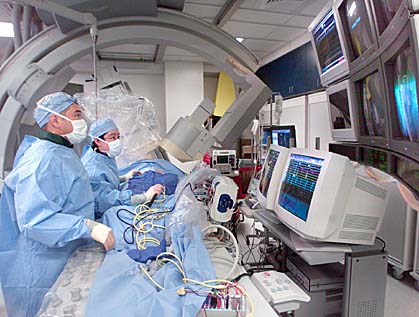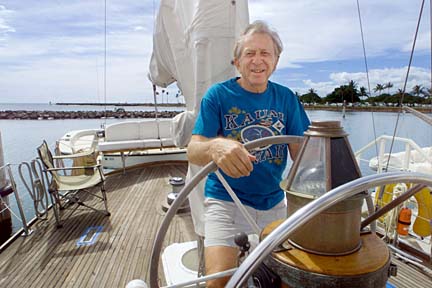
DEAN SENSUI / DSENSUI@STARBULLETIN.COM
Electrophysiologist Dr. Francis Ngo works on a patient at Kaiser Permanente's Moanalua Medical Center.
Isle hospitals map
heart problemsKaiser Permanente and Maui
Memorial have a system that
cures arrhythmia fast
Two Hawaii hospitals are using a system that cures some abnormal heart rhythms, eliminating the need for medications, pacemakers and open heart surgery, cardiac specialists say.
The system creates a three-dimensional map of the heart to pinpoint the source of abnormal electrical activity causing arrhythmia.
Kaiser Permanente's Moanalua Medical Center acquired the cutting-edge, computerized electrical mapping system about two months ago. Maui Memorial Medical Center has had it about five years.
Dr. Francis Ngo, Hawaii Permanente Medical Group director of cardiac electrophy- siology, said the system has revolutionized the diagnosis and treatment of arrhythmia.
"With this system, we're able to cure patients so they don't have to take lifelong medications," said Ngo, a cardiologist specializing in abnormal heart rhythms and electrical disturbances.
Jerome Sinay, 72, a former nursing home administrator who was one of the first Kaiser patients to use the system, said he had been taking almost the maximum dose of medication for his arrhythmias.
"I don't know what I would have done in the future," he said, noting every man on his mother's side of the family died from the same condition.
He underwent a procedure two years ago to treat his abnormal heart rhythm, but doctors could not get a catheter deep enough into the tissue to reach the source, he said.
Sinay and his wife, Lallie, live at the Ala Wai Yacht Harbor on a 65-foot yacht, Mystic. He has taken it around the world twice but was slowed down the past three years by his heart problems, he said.
DEAN SENSUI / DSENSUI@STARBULLETIN.COM
Jerome Sinay, 72, was one of the first Kaiser Permanente patients to use the heart system.
He left the Moanalua hospital the day after Ngo treated him with the new system Aug. 29, and two weeks later was working in a franchise partnership for Lindal Cedar Homes. He said his doctor told him in a recent checkup, "Your heart is perfect."
"I'm so obliged to Dr. Ngo for performing this procedure," he said. "He gave me my life back. My lifestyle changed back to my lifestyle of former years."
Ngo said there are other systems but none as precise as the Carto EP Navigation System developed by Biosense Webster, a Johnson & Johnson company.
Two-dimensional fluoroscopy, a type of X-ray, is the conventional method used to help diagnose the type and location of an arrhythmia.
The new system enables construction of a 3-D anatomical map of the heart with a special catheter (thin tube) inserted through veins, Ngo explained. The electrical activity is color-coded on the map to identify the source of erratic signals.
Energy is transmitted into the tissue through the tip of a catheter to disrupt the electrical pathway causing the problem, a technique known as catheter ablation.
The newer catheters get into deeper tissue, said Rosemary Bailey, Biosense Webster professional education specialist training Ngo's team.
She said the system was developed in Israel using military technology and patterned after a global positioning system, with three magnets used to create a magnetic field around the heart.
Dr. Mark Schwab, Maui electrophysiologist, said he and Dr. Koonlawee Nademanee, of the Tommy Lasorda Heart Institute of Los Angeles, have been working with the system for five years.
He said Nademanee is a noted researcher, "one of the early innovators in the area," and the king of Thailand's doctor. He was due to arrive yesterday from Bangkok to work with him three days on ablation of arrhythmias, Schwab said.
He said they are trying to establish Maui as the cardiovascular center for the Hawaii Health Systems Corp. hospitals. "The objective is to serve the outer islands from Maui Memorial."
Ngo said more than 4 million Americans, including about 150,000 Hawaii residents, have some form of arrhythmia, risking heart attack, stroke and death. Symptoms may include shortness of breath, palpitations or fatigue.
Conventional treatments involve "tremendously expensive" medications or surgically implanted pacemakers or defibrillators, which affect quality of life and do not cure the problem, he said.
Building a 3-D picture recently of a sedated 66-year-old man's heart, Ngo zeroed in on the source of arrhythmia and injected energy into the tissue to break the electrical pathway responsible.
"Right now, this guy is cured," said Jeff Levin, Biosense Webster regional sales manager, observing the patient's heart rhythm on the computer.
Ngo said he is using the system for particularly difficult and challenging cases. It is invaluable for ventricular tachycardia, involving very fast heart rhythm at the bottom part of the heart, which "can cause people to pass out or worse," he said.
He hopes to target atrial fibrillation, one of the most common forms of arrhythmia, as his staff gains more experience with the system and the still-developing technology "steadies out."
Schwab said he and Nademanee have been able to treat all pediatric and adult abnormal heart rhythms at Maui Memorial. Atrial fibrillation could not be treated before, but he has sent about 30 patients to Nademanee, who has developed a technique to treat it, he said.
Ngo said the mapping procedure takes three to four hours. "We're slow and methodical," he said, explaining his team tries to trigger fast heart rhythm when they are finished to make sure it does not return.
His group includes electrophysiology nurse coordinator Karen Matsushima, three radiology technicians and a nurse administering constant medication.
The only electrophysiologist for Kaiser's 235,000 patients, Ngo said he would not have the $250,000 system without the support of Dr. Mike Chaffin, president of the Hawaii Permanente Medical Group, Al Mariana, chief of the Department of Surgery, and Paul Ho, chief of cardiology.
"We knew we'd have to invest quite a bit of money to offer our patients state-of-the-art care."

